SUNY Oneonta dining services, operated by Sodexo, implemented the LeanPath program in late August 2013, installing three units in three restaurant-style residential dining halls that serve the 3,400 students on the university’s unlimited meal plan.
Rebecca Molloy is the Operations Director, overseeing the day-to-day operations in all the foodservice locations around campus, and Rex Smith is the Production Manager, responsible for menus and recipes, forecasts, and food waste analysis. We spoke with both of them about the work they are doing to reduce food waste.
What drove you to start the LeanPath program?
Rebecca: "Our district manager, Steve O’Reilly, wanted to implement LeanPath across all campuses because he believes it is a great tool to cut food costs. We also wanted a tool to bring more food waste info to light."
Had you ever tried to track food waste before?
Rebecca: "We did a little bit of food waste tracking in one of our dining halls before implementing LeanPath by counting and weighing garbage bags filled with food waste. It wasn’t very accurate; it was more of an eyeball estimate."
What were your expectations for the program?
Rex: "I thought we would identify some areas of saving waste or reducing our waste, and as we have progressed through these 12 weeks we are definitely seeing a trend in the right direction."
Have you been able to quantify savings due to waste reduction?
Rex: "When we started, I found that our waste, at least in the residential dining halls, was roughly four cents per plate. Now it’s down to just over two cents per plate—we’ve reduced it by two cents, which is very significant when you add it up. I think at the peak, the cost of our weekly waste was right around $2,000, and we’re around $1,000 now—we’re saving about $1,000 a week."
What changes have you seen in terms of culture?
Rex: "The LeanPath system has improved communication and awareness. Employees really look forward to seeing the results of their efforts. Everyone is on board and likes to contribute to the success of the program. When we have an overproduction issue in one of our stations, before the item becomes waste, the staff members communicate with each other to see where an item can be utilized in another area."
What is the best part about using the LeanPath System?
Rex: "The increase in awareness and communication with employees regarding food waste. To see how much they care about reducing waste—that’s been a very positive experience for us."
Rebecca: "General increase in awareness of food waste. Most of our waste is post-consumer, but students are aware of us using LeanPath, and both they and our sustainability coordinator are very excited about it."
What would you say to a chef/manager that is not currently tracking food waste?
Rex: "If you have some concern about high waste or food cost, give it a shot. LeanPath really involves the employees; it gets them excited. The problem solving that we go through together as a team is part of the success."



